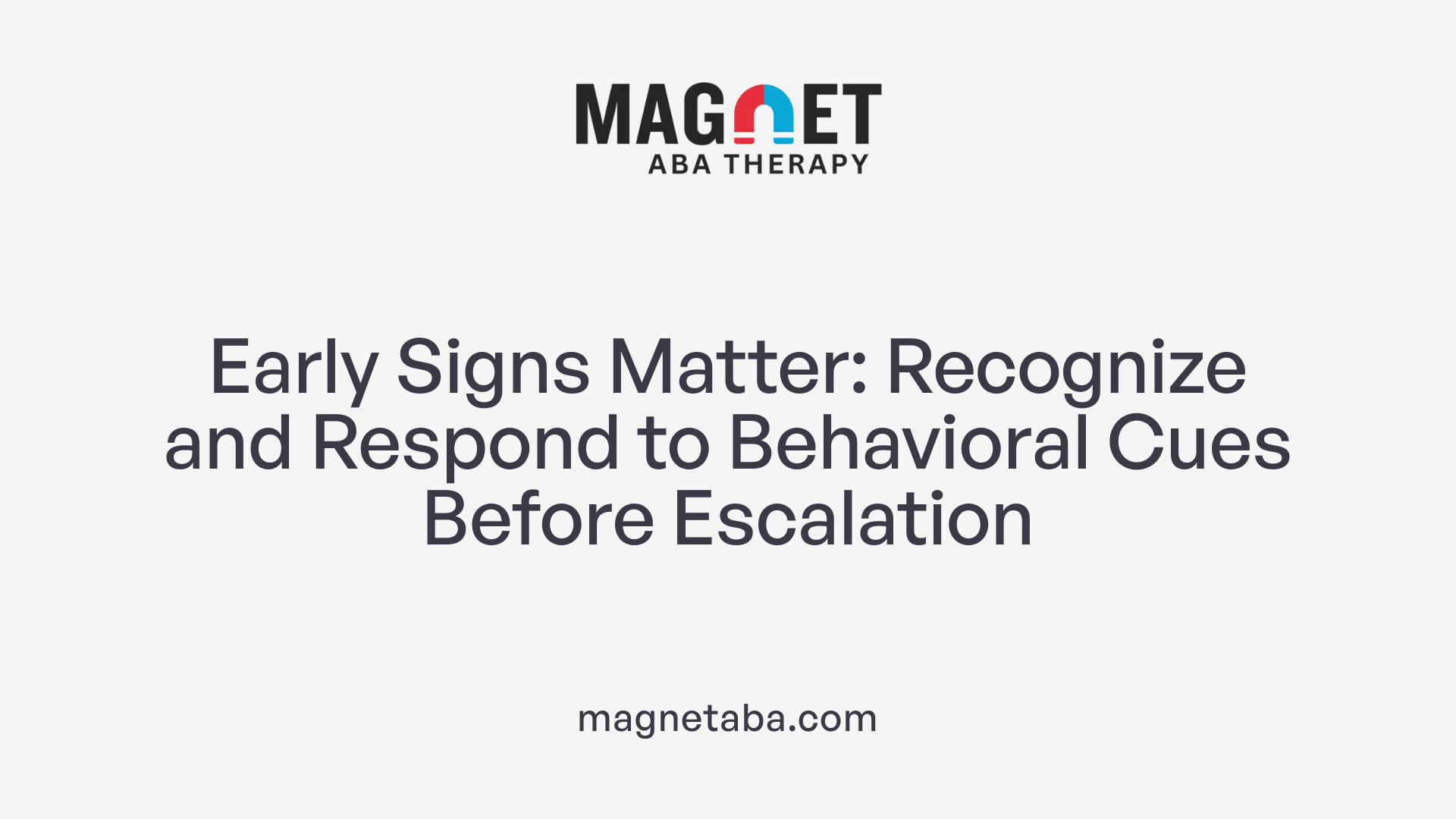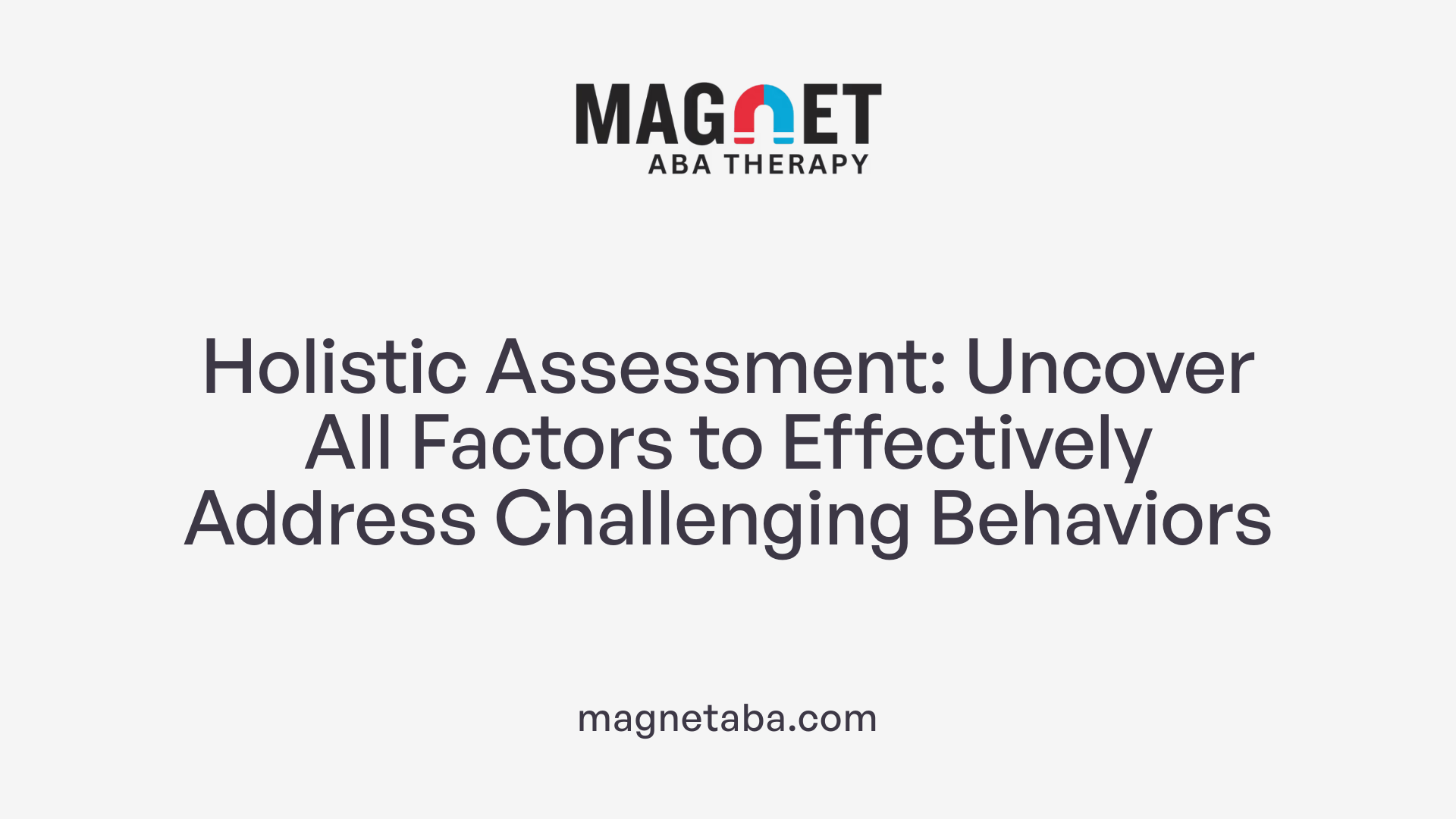Understanding the Foundations of Trigger Identification
Recognizing and understanding triggers for challenging behaviors is a vital step in creating supportive environments for individuals with special needs or behavioral challenges. These triggers are often subtle and multifaceted, requiring caregivers, educators, and professionals to engage in careful observation and systematic assessment. This article explores comprehensive strategies for identifying triggers, differentiating their types, analyzing behavioral patterns, and applying evidence-based interventions to prevent escalation and promote positive change.
Understanding Challenging Behaviors and Their Triggers

Actions like hitting, biting, shouting, withdrawal
Challenging behaviors often manifest as actions such as hitting, biting, kicking, shouting, self-injury, disruptive behaviors, and withdrawal. These actions can interfere with learning, safety, and social interactions, impacting both the individual and those around them. Recognizing these behaviors as expressions of unmet needs or responses to triggers is essential for effective support.
Common triggers: communication issues, sensory overload, change in environment, physical discomfort, unmet needs
There are numerous triggers that can provoke challenging behaviors. These include communication misunderstandings where an individual may struggle to express needs, sensory overload from loud noises or bright lights, sudden changes in routines or environments, physical discomfort like pain or illness, and unmet needs or desires such as hunger or thirst. Emotional factors like anxiety, stress, frustration, anger, depression, and past trauma can also serve as catalysts.
Behavior serves a purpose, such as seeking attention or avoiding distress
Every challenging behavior typically has a function or purpose. For instance, a person might hit or shout to gain social attention or to communicate frustration. Similarly, behaviors like withdrawal or running away may serve as ways to escape an uncomfortable situation or sensory overload. Understanding these functions is crucial for developing supportive and effective interventions.
How can caregivers recognize triggers for challenging behavior?
Caregivers can identify triggers by observing and recording behaviors meticulously over time. Utilizing tools like ABC (Antecedent, Behavior, Consequence) charts helps in noting what happens before and after a behavior. Details such as the time of day, location, involved individuals, and preceding activities are valuable. Recognizing patterns through consistent documentation reveals specific situations or stimuli likely to provoke behaviors like tantrums or meltdowns.
What are common triggers for challenging behavior?
The most common triggers include both immediate events and broader setting factors. These encompass situations like being told "no" or requests being refused, environmental noise or chaos, physical discomfort, and health issues such as pain or illness. Emotional triggers include recent losses, anxiety, and mood fluctuations, potentially exacerbated by sensory sensitivities or sleep disturbances. Understanding these triggers allows for preventative measures, like adjusting routines or environments.
How can behavioral patterns be observed and analyzed to identify triggers?
Behavioral patterns are identified through diligent observation and systematic recording of responses to various stimuli. Caregivers should note the context—such as location, time, and whom the individual is with. Watching for early signs of distress, like physical cues or emotional reactions, helps uncover specific triggers. This process involves analyzing behaviors in relation to environmental and emotional factors to see what consistently precedes challenging actions.
How do you differentiate types of behavioral triggers and their impact?
Differentiating triggers involves understanding their sources—whether immediate, physical, emotional, or contextual. Immediate triggers are specific events like loud noises or abrupt requests, while emotional triggers relate to internal states like anxiety or trauma memories. Physical triggers include pain or fatigue. Recognizing these distinctions aids in developing targeted strategies, such as environmental modifications for sensory triggers or emotional regulation techniques for mood-related triggers.
What strategies can help in preventing and managing challenging behaviors by understanding their triggers?
Prevention begins with thorough assessment and understanding of individual triggers. Strategies include creating predictable routines, fostering clear communication, using visual supports, addressing physical discomfort promptly, and teaching self-regulation skills. Employing positive behavior support techniques such as praise, reinforcement of alternative behaviors, and environmental adjustments helps reduce the likelihood of challenging behaviors. Training staff and caregivers ensures consistent, supportive responses.
What is the importance of understanding the cycle of challenging behavior?
Recognizing the cycle—comprising trigger, escalation, crisis, and recovery—enables adults to intervene at early stages. This understanding allows for timely de-escalation, reducing the severity and duration of challenging behaviors. It also supports tailored interventions that address underlying causes, fostering emotional regulation and safety. Comprehending the cycle helps create a supportive environment where individuals feel understood and respected, promoting positive behavioral changes and well-being.
Using Assessment Tools to Pinpoint Triggers

How can caregivers recognize triggers for challenging behavior?
Caregivers recognize triggers by observing and documenting their child's actions carefully. This involves paying attention to details such as the time, location, the activities happening before the challenging behavior, and who is present. Keeping consistent records can reveal patterns, helping identify specific situations or stimuli—like loud noises or changes in routine—that provoke outbursts like tantrums or meltdowns.
Since triggers are not always obvious, ongoing observation and investigation are essential. Understanding potential triggers allows caregivers to anticipate situations that might cause distress, so they can prepare or intervene early. Strategies such as calming techniques or offering choices can then be implemented to manage reactions effectively. Overall, awareness and detailed record-keeping are vital in reducing challenging behaviors by addressing their root causes.
How do assessment tools aid in identifying triggers?
Assessment tools like ABC charts and the comprehensive CATS scale provide structured ways to record and analyze behavioral data. ABC charts focus on documenting what happens immediately before (Antecedent), during, and after (Consequence) a challenging behavior. Using these charts helps in identifying patterns related to specific triggers, whether environmental or internal.
The CATS (Comprehensive Assessment of Triggers for behaviours of concern scale), developed through caregiver interviews and literature review, lists hundreds of potential triggers categorized under main domains. These tools enable caregivers and professionals to systematically gather observations over time, making it easier to hypothesize about underlying causes.
Consistent use across different situations ensures objective, comparable data, which lead to more accurate identification of triggers. This process guides tailored intervention strategies, increasing the chances of behavior improvement.
Why is consistent documentation important during assessment?
Consistent and detailed documentation creates a reliable record of behaviors and their contexts. Such records highlight recurring patterns, making it easier to identify specific triggers or set-up conditions linked to challenging behaviors.
Accurate records support hypothesis formation about the functions of behaviors, like seeking attention, avoiding demands, or automatic reinforcement. This understanding is fundamental for developing effective, personalized support plans.
Moreover, thorough documentation fosters better communication among caregivers, professionals, and educators. It ensures everyone is aligned in understanding the behavior patterns, allowing for coordinated responses and ongoing evaluation. Regular updates and systematic recording facilitate adjustments to strategies, promoting continuous progress.
How can caregivers differentiate between triggers and setting events?
Triggers are immediate stimuli that directly lead to a behavior, such as being told to sit still or having a toy taken away. Setting events, on the other hand, are broader factors that indirectly increase the likelihood of a trigger causing a challenging behavior.
Examples of setting events include hunger, fatigue, or recent changes in routine. These factors may not cause the behavior directly but can heighten sensitivity to triggers. For instance, a child who is tired (a setting event) might react strongly to a loud noise (the trigger).
Caregivers can differentiate between them by observing over time how certain broad factors influence reactions to specific triggers. Recognizing this connection allows for environmental adjustments—like ensuring regular breaks or managing routine changes—to reduce overall vulnerability to challenging behaviors.
Recognizing Early Warning Signs of Challenging Behavior

What are early warning signs of triggers for challenging behavior?
Identifying the initial signs of potential challenging behaviors is crucial for effective intervention. Early warning signs often include observable changes in a person's behavior such as increased irritability, withdrawal from social interactions, or noticeable agitation. These behavioral shifts may occur days or hours before a full-blown challenging episode.
Physical cues are also important indicators. Caregivers and support staff should watch for signs like a rapid heartbeat, flushed cheeks, muscle tension, increased breathing rate, or fidgeting. Such physiological responses can reflect rising stress levels or discomfort.
On an emotional level, signs like heightened anxiety, frustration, or emotional distress can precede disruptive behaviors. Recognizing these subtle cues requires attentive observation and familiarity with an individual’s typical patterns.
Proactively monitoring these early signs enables carers to intervene before behaviors escalate into significant crises. For example, if someone starts to show signs of withdrawal and physical tension, providing reassurance, adjusting the environment, or offering preferred calming activities can help prevent a challenging outburst.
The importance of ongoing observation cannot be overstated. Keeping track of these indicators, especially during known stressful situations such as routine changes or sensory overload, allows for timely support. Interventions might include sensory breaks, reassurance, or modifying the environment to better support emotional regulation.
By understanding and acting upon these early warning signs, caregivers can reduce the severity and frequency of challenging behaviors. This preventative approach fosters a safer, calmer environment and promotes better emotional well-being for individuals prone to difficult behaviors.
Overall, training staff and family members to recognize these signals and respond appropriately is an essential component of managing challenging behaviors effectively. It emphasizes that most behaviors are communicative and can be addressed early with awareness and empathy.
Recognizing the early signs also plays a vital role in developing personalized care plans. When these cues are identified early, support strategies can be tailored to meet specific needs effectively, enhancing the individual’s ability to cope with stressors and reducing triggers altogether.
Addressing Underlying Causes Through Holistic Assessment

What is the importance of understanding the cycle of challenging behavior?
Recognizing the cycle of challenging behavior is vital because it helps caregivers, educators, and professionals respond appropriately at each stage. This cycle generally involves an initial trigger, escalation, a crisis point, and eventual recovery. By understanding these stages, adults can identify early warning signs such as irritability, withdrawal, or emotional distress, which can prevent behaviors from escalating.
Intervening early can maintain safety and promote emotional regulation. For example, if a caregiver notices signs of stress before a meltdown, they can implement calming strategies or remove stimuli that contribute to the escalation. This proactive approach not only reduces the chances of crisis but also supports the individual in developing better self-awareness and coping skills.
Knowing the behavior cycle allows for tailored, individualized strategies that address the root causes rather than just managing symptoms. These strategies foster a respectful environment where individuals feel understood and supported. Ultimately, understanding this cycle helps create more positive interactions, reduces frustration, and leads to better behavioral and developmental outcomes.
Why is a holistic approach crucial in identifying triggers?
A comprehensive, holistic approach is crucial because challenging behaviors often stem from complex and interconnected factors. Medical issues like pain or illness, psychological conditions such as trauma or anxiety, environmental influences, and social dynamics all potentially contribute to the behaviors observed.
By adopting a holistic perspective, professionals and caregivers assess all these layers rather than focusing on a single cause. This is achieved through collaboration with multidisciplinary teams including healthcare providers, psychologists, educators, and families. Together, they gather detailed information about physical health, emotional state, environmental stressors, and social interactions.
This team-based assessment ensures that no aspect of the individual’s life is overlooked. For example, a child’s disruptive behavior might be linked to sensory overload, unmet emotional needs, or environmental noise. Addressing only one factor might be ineffective if others are also influencing the behavior.
Developing personalized support strategies through this approach can involve environmental modifications, health interventions, social skills training, or trauma-informed care. When triggers are correctly identified, interventions become more targeted and sustainable.
In summary, a holistic approach promotes a deeper understanding of the individual, leading to more effective, compassionate, and long-lasting solutions that improve overall well-being and reduce the frequency of challenging behaviors.
| Aspect | Approach | Details |
|---|---|---|
| Medical Factors | Comprehensive health assessment | Includes checking for medication side effects, pain, or illness |
| Psychological Factors | Psychological evaluation and therapy | Identifies trauma, anxiety, depression, or other mental health issues |
| Environmental Factors | Modifications and assessments | Noise levels, routines, physical environment considerations |
| Social and Cultural Factors | Family and community context | Cultural practices, social support, peer interactions |
| Collaborative Efforts | Multidisciplinary teams | Doctors, therapists, teachers, caregivers working together |
| Support Plans | Tailored interventions | Based on multi-layered assessments, incorporating all factors |
This integrative approach enables a deeper understanding of triggers, allowing targeted, respectful support that addresses each individual’s unique needs and circumstances.
Creating Safe and Supportive Environments

How can environmental factors influence triggers?
Environmental elements play a crucial role in triggering challenging behaviors. Factors such as noise levels, lighting, temperature, privacy, and the overall physical environment can either escalate or reduce stress for individuals.
Loud noises or bright lights might cause sensory overload, especially in those with sensory processing issues, leading to heightened irritability or aggression. Extreme temperatures can cause discomfort, prompting distress or disruptive actions.
Unfamiliar settings or sudden changes in the environment can evoke anxiety or confusion, which may manifest as withdrawal or outbursts. These triggers are often subconscious responses to feeling unsafe or overwhelmed.
To create a supportive environment, modifications are essential. Establishing calm spaces where individuals can retreat when overwhelmed helps regulate emotions. Adjusting lighting, reducing background noise, and maintaining a consistent, predictable routine minimize surprises and uncertainty.
Thoughtful environmental planning, such as using soft colors, controlling sensory stimuli, and ensuring privacy, can significantly decrease triggers. Regular assessments and feedback from individuals help maintain an environment that fosters safety and self-regulation.
What trauma-informed strategies can be used to address triggers?
Trauma-informed approaches recognize that many challenging behaviors stem from past traumatic experiences. These strategies aim to create a sense of safety, trust, and control for the individual.
A fundamental principle is establishing predictability. Consistent routines and clear communication help reduce anxiety linked to uncertainty.
Building positive relationships through empathy and active listening encourages individuals to feel valued and understood. Offering choices empowers them to regain a sense of control, which is often compromised after trauma.
Validation of feelings is essential. Acknowledging emotions without judgment helps in de-escalating distress and promotes emotional healing.
Avoiding re-traumatization involves careful consideration of interactions and environments. For example, avoiding abrupt or forceful procedures, and ensuring physical and emotional safety during interventions.
Additional strategies include using sensory regulation techniques, like calming activities or tools, to help manage emotional responses.
Collaboration with mental health professionals ensures tailored support plans that address trauma-specific triggers. This holistic approach fosters resilience, trust, and healthier behavioral responses, ultimately leading to a safer environment.
Building trust and predictability
Trust and predictability serve as the cornerstone for reducing triggers associated with uncertainty and fear. Consistent routines, clear expectations, and transparent communication all contribute to this foundation.
Sharing daily plans, using visual schedules, and giving advance warnings before transitions help individuals prepare emotionally. This reduces the likelihood of reactive behaviors triggered by sudden changes.
Establishing safety routines, like greeting rituals or designated quiet areas, reinforces a sense of security. Engaging individuals in creating these routines fosters ownership and compliance.
Quality interactions that center on empathy, active listening, and reassurance strengthen trust. When individuals feel understood, they are more likely to collaborate in managing their behaviors.
Creating an environment where questions are encouraged and experiences are validated enhances emotional stability. Such an approach promotes self-awareness and helps individuals recognize their triggers early.
In summary, environmental modifications, trauma-informed strategies, and fostering trust and predictability are interconnected approaches. They collectively help in minimizing triggers and supporting individuals to achieve better emotional regulation and adaptive behaviors.
Using Personalized Support Plans to Address Triggers

How can ongoing observation and assessment inform intervention strategies?
Continual observation and assessment are vital components in understanding how triggers influence an individual's behavior over time. By systematically recording behaviors, environmental factors, and responses, caregivers and professionals gather valuable data that reveal patterns and emerging triggers. This process helps identify what specific circumstances or sensory inputs lead to challenging behaviors.
Regularly analyzing this information allows support teams to evaluate whether current strategies are effective or need adjustment. For example, if a particular environmental change consistently triggers disruptive behavior, modifications can be made proactively. Moreover, ongoing assessment helps in developing new skills or reinforcing existing positive behaviors.
This dynamic approach ensures support strategies are tailored to the individual's evolving needs. It also fosters consistency and reliability in managing behaviors, which is crucial for building trust and promoting safety. Regular assessments enable the refinement of environmental modifications, communication techniques, and behavioral interventions, resulting in a more responsive and effective support plan.
Ultimately, the continuous cycle of observation and assessment supports a flexible system that adapts to the person, ensuring interventions are both effective and respectful. This personalized approach enhances behavioral outcomes and supports the individual's overall well-being.
What role does positive behavior support play in trigger management?
Positive Behavior Support (PBS) is a foundational strategy in managing triggers effectively. It begins with understanding the function behind each challenging behavior, which is often linked to unmet needs or environmental factors. By analyzing triggers, PBS aims to develop proactive plans that prevent the occurrence of these behaviors.
One of the core principles of PBS is teaching individuals alternative, appropriate ways to meet their needs, therefore reducing the likelihood of challenging behaviors. This includes skill-building in communication, emotional regulation, and problem-solving, which empowers individuals to better cope with triggers.
Reinforcing positive behaviors through praise, rewards, or other supports encourages their recurrence and helps establish new behavioral patterns. Person-centered planning ensures that interventions respect individual preferences, strengths, and cultural backgrounds.
Importantly, PBS advocates for addressing triggers directly by modifying the environment—such as reducing sensory overload or clarifying routines—and supporting individuals during moments of increased stress. This comprehensive, anticipatory approach minimizes reactive responses and fosters lasting behavioral improvements.
In essence, positive behavior support not only manages triggers but also equips individuals with skills and strategies that promote independence and emotional well-being. It shifts the focus from punishment to understanding and growth, leading to a more supportive and effective behavioral management system.
Adjustments Based on Response
Effective support plans are dynamic and adapt based on the individual's response to various interventions. As strategies are implemented, ongoing monitoring provides feedback on what is working and what requires alteration.
For example, if modifying the environment reduces a specific trigger, this adjustment can be reinforced. Conversely, if a particular intervention doesn't produce the expected change, the plan should be reassessed and tailored further.
Flexibility is essential because individuals' needs and reactions can change due to developmental progress, external circumstances, or emotional states. Regular review meetings with caregivers, professionals, and the individual ensure that strategies remain relevant and effective.
This responsive approach encourages a cycle of continuous improvement, where data-driven decisions lead to more precise targeting of triggers and supports. It also promotes a sense of collaboration and empowerment for everyone involved.
By being responsive to the person's progress and challenges, personalized support plans become more effective, respectful, and sustainable, ultimately supporting a better quality of life and increased independence for individuals with complex needs.
Moving Forward with Triggers Awareness
Identifying triggers for challenging behaviors is a process rooted in careful observation, systematic assessment, and compassionate understanding. Utilizing tools like ABC charts and comprehensive scales such as CATS enables caregivers and professionals to uncover the specific stimuli that provoke distress. Differentiating among triggers, recognizing early warning signs, and addressing underlying causes through holistic, trauma-informed, and person-centered strategies cultivate safer, more supportive environments. Ongoing education, collaborative teamwork, and personalized support plans empower caregivers to intervene effectively, ultimately reducing the frequency and intensity of challenging behaviors. By mastering the art of trigger identification, we pave the way for meaningful behavioral change, enhanced emotional well-being, and improved quality of life for the individuals we serve.
References
- What Can Trigger Behaviours That Challenge and How to Prevent it?
- [PDF] Identifying Triggers of Challenging Behaviour from an ABC Chart
- [PDF] Finding the Reasons for Challenging Behaviour: Part 2
- Identifying your child's behavior triggers - Understood.org
- [PDF] Navigating Through Challenging Behaviors - DSHS
- 5 Tips for Identifying What Might Be Triggering Problem Behavior
- Behaviours That Challenge: Triggers and Prevention
- Comprehensive Assessment of Triggers for Behaviours of Concern ...
- Students: 3. Challenging behaviour influences and triggers
- Understanding the Cycle of Challenging Behaviour











